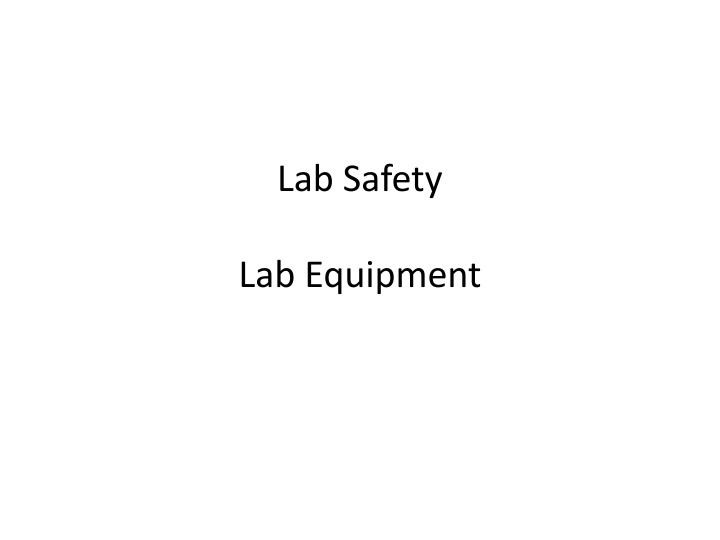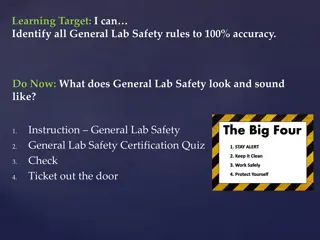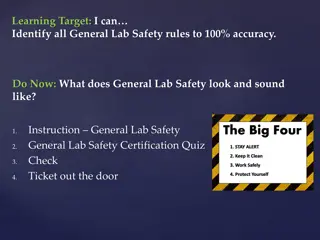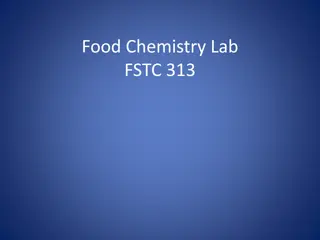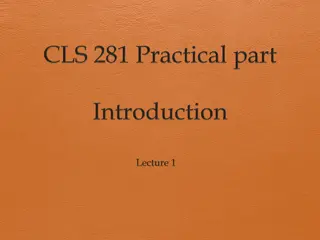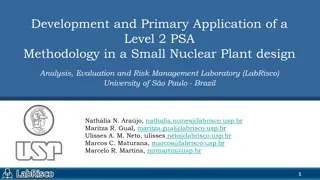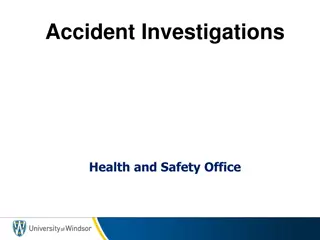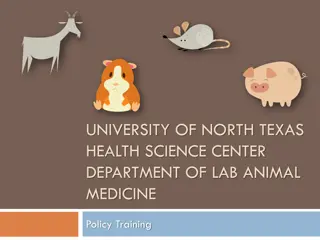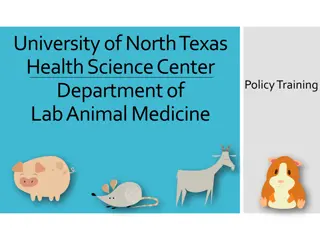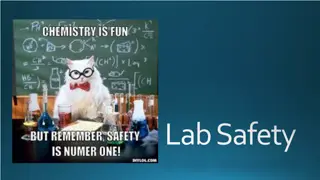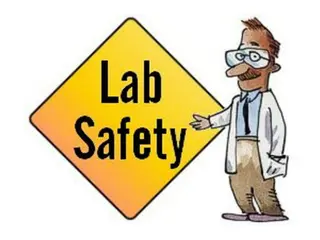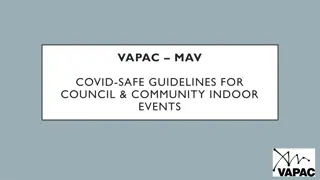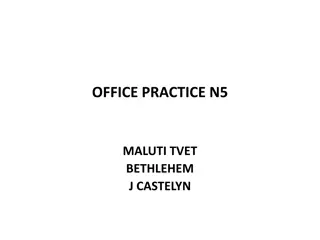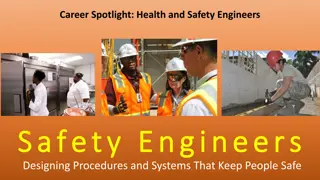Lab Safety Guidelines for a Safe and Accident-Free Environment
Lab safety is crucial for maintaining a safe and accident-free environment in various scientific settings. Following directions, using equipment properly, and understanding safety symbols are key aspects of ensuring safety in labs. From wearing protective gear like aprons and goggles to handling hot materials with care, these guidelines emphasize the importance of preventing injuries and maintaining a secure workspace.
Download Presentation

Please find below an Image/Link to download the presentation.
The content on the website is provided AS IS for your information and personal use only. It may not be sold, licensed, or shared on other websites without obtaining consent from the author.If you encounter any issues during the download, it is possible that the publisher has removed the file from their server.
You are allowed to download the files provided on this website for personal or commercial use, subject to the condition that they are used lawfully. All files are the property of their respective owners.
The content on the website is provided AS IS for your information and personal use only. It may not be sold, licensed, or shared on other websites without obtaining consent from the author.
E N D
Presentation Transcript
Lab Safety Lab Equipment
Objective Following directions + using equipment properly = Safe and accident free lab environment
How does lab safety affect me? Zombie Video
Safety Symbols Usually only in Chemistry Common to all Sciences Corrosive Apron Proper Disposal Heating Glassware Goggles Hand Washing Fumes Glassware General Safety Heat-resistant gloves Usually only in Biology Toxic/poison Electrical Shock Open Flames Sharp Objects No Open Flames Plant Safety Physical Safety Animal Safety
Explanation of Symbols Apron- Wear a lab apron to protect skin and clothing. Goggles- Wear safety goggles to protect your eyes during labs that use chemicals, flames or heating, or the possibility of broken glass. Glassware- handle breakable materials with care. Do not handle broken glass. Heat-resistant gloves Use hand protection when handling hot materials. Do not touch hot materials with bare hands. Electrical Shock- Never use electrical equipment around water, or when equipment or hands are wet. Be sure cords are untangled and can t trip anyone. Disconnect equipment when not in use. No Open Flames- Flammable materials may be present. Make sure no flames, sparks, or exposed heat sources are present. Physical Safety- When an experiment involves physical activity, take precaution not to injure yourself or others. Alert your teacher of any reason that you should not participate in the activity.
Explanation of Symbols Proper Disposal- Not everything goes in the trash or sink. Follow teacher s directions as to where to dispose of all materials. Hand Washing- Wash hands thoroughly after all lab activities. General Safety- Follow additional safety precautions given by your teacher. Toxic/poison- Do not let poisonous chemicals come in contact with your skin, clothing or eyes. Do not inhale vapors. Wash hands when you are done with the activity Open Flames- You will be working with open flames. Tie back loose hair and clothing. Follow teacher s instructions about lighting and extinguishing flames. Corrosive- Do not let chemicals come in contact with your skin, clothing or eyes. Do not inhale vapors. Wash hands when you are done with the activity Heating Glassware- Use a clamp or tongs to handle hot glassware. Do not pick up hot glassware with your hands. Fumes- Work in a well-ventilated area or the fume hood. Do not inhale directly. Use wafting if you are to test the odor of a vapor.
Explanation of Symbols Sharp Objects- scissors, scalpels, knives, needles, pins, or tacks, can cut or puncture your skin. Always direct sharp edge or point away from yourself and others. Use sharp instruments as suggested. Plant Safety- Handle plants only as directed by your teacher. If you are allergic to certain plants, tell your teacher before an activity. Avoid touching poisonous plants or plants with thorns. Wash your hands after activity. Animal Safety- Treat live animals with care to avoid harming the animals or yourself. Working with animal parts or preserved animals also may require caution. Wash your hands after handling any animal specimen.
Lab Safety Rules Dress Code 1. Wear safety goggles when directed. Never wear contact lenses in the lab. 2. Wear a lab coat or apron when directed. 3. Tie back loose hair whenever chemicals or open flames are being used. 4. Do not wear loose, baggy clothing or loose jewelry (ID badge lanyards) when working with chemicals or open flames. Always wear shoes (no sandals, flip-flops, or exposed toes or feet. General Safety 5. Never horse around in the lab. Be serious and alert. 6. Be ready to work when you enter the lab. Understand the procedures before you begin and any hazards associated with the lab. 7. Read all directions before the lab. If you are unsure of proper procedure, ask your teacher before proceeding. 8. Never perform activities that are not authorized by your teacher. Obtain permission BEFORE you do something that you are not supposed to be doing. 9. Never handle any equipment without permission from teacher. 10. Do not spill anything. If you do tell the teacher immediately so that you can clean it up according to proper procedure. 11. Never eat, taste, or drink anything. Do not apply cosmetics. Wash hands before and after each activity.
12. Know location and use of safety equipment in lab. 13. Notify teacher of any health issues you may have, such as asthma, allergies, etc 14. Keep your area neat and free of clutter. No books, bags, unnecessary papers etc First Aid 15. Report all accidents, no matter how minor, immediately to the teacher. 16. Know what to do in the case of specific accidents such as acid spills, fires, or chemicals on skin or in eyes. 17. Know the location of the first aid kit, Nurse s and Office phone number and how to respond in case of an emergency. Your teacher should administer any first aid that you require, but if the teacher goes down you need to help. Heating and Fire Safety 18. Never used a heat source such as a candle or burner without wearing goggles. 19. Never heat anything that you are not instructed to heat. 20. Keep work area clear of clutter. 21. Never reach across a flame. 22. Make sure you know how to light a bunsen burner. If you do not your teacher will show you. 23. Point test tubes or bottles that are being heated away from you and others. Chemicals can boil or splash out of the tube. 24. Never heat a closed container. 25. Never pick up a container without first checking to see if it is hot. If you can feel heat when you hold the back of your hand near it, use heat gloves or tongs to pick it up.
Using Chemicals Safely 26. Never mix chemicals for the fun of it. See unauthorized experiments (rule #8). 27. Never touch, taste, smell etc any chemical unless instructed to do so. 28. Use only the chemicals need for an investigation. Keep all lids closed when a chemical is not in use. Notify teacher if spills occur. 29. Dispose of all chemicals as instructed by teacher. To avoid contamination do not return chemicals to their original containers. 30. Be careful when working with chemicals such as acids or bases. Always pour them over the sink rather than over your work area. 31. When diluting an acid always add small amounts of Acid to Water. A to W. Ahhh. W to A. WAAAAA! 32. Rinse acids or bases off of skin immediately. Notify teacher immediately of spills. Glassware Safety 33. Never force glass tubing into a rubber stopper. Your teacher will demonstrate the proper procedure to do this. 34. Never heat glassware that is not dry. Use wire gauze to protect glass from the flame. 35. Hot glass does not look hot. Don t pick up any glassware that may have been heated without checking to see if it is hot first. 36. Never use broken or chipped glassware. If glass breaks, tell teacher immediately and dispose of glass in GLASS BOX. 37. Never eat or drink out of lab glassware.
Using Sharp Instruments 38. Handle scalpels and razor blades with extreme care. Never cut material toward yourself or others. Cut away from you and others. 39. Be careful with sharp stuff. (See sharp object safety symbol) 40. Notify your teacher if you cut yourself. Handling Living Organisms 41. No investigations that will cause pain, discomfort, or harm to mammals, birds, reptiles, fish, and amphibians should be done in the classroom or at home. 42. Treat all living things with care and respect. Do not touch any organism in the classroom or lab without permission. (see plant and animal symbols as well) 43. Animals should be handled only if necessary. If an animal is excited or frightened, pregnant, feeding, or with its young, special handling is required. 44. Your teacher will instruct you as to how to handle each species that may be brought into the classroom. 45. Treat all microorganisms as if they were harmful. Use antiseptic procedure, as directed by your teacher, when working with microbes. Dispose of microbes as your teacher directs. 46. Clean your hands thoroughly after handling animals or the cage containing them. 47. Wear gloves when handling small mammals. Report bites or stings to teacher immediately. Clean up Rules 48. When done do the following: Clean up. Put away correctly. Turn off/unplug. Wash hands.
Parts of a microscope Microscope basics
Graduated cylinder Used to make accurate measurements of liquid volumes. The bumper ring on larger cylinders is to prevent breakage if tipped over.
Measuring the Volume of a liquid with a graduated cylinder The top of a liquid in a cylinder curves to form what is known as a meniscus. Read the bottom of the meniscus to measure the amount of liquid in the cylinder! The smaller the container the greater the curve.
Triple Beam Balance The balance is named for its three "beams". How to use the Triple Beam Balance: The tares, or weights are moved to ZERO An object is placed on the pan of the balance Facing the balance the back beam is in 10 gram steps ( 10g 20g 30 g ) the middle beam is in 100 gram steps (100g 200g ) the front beam is in 1 gram steps (1g 2g 3g ) 1st move the 100g step to the next notch 2nd move the 10g step to the next notch 3rd move the 1g step to the next notch It is very important that the tares on these two beams are in the notch for the whole number of grams and not in between notches. Total mass = (100g beam) + (10g beam) + (1g beam)
Using Litmus Paper Base = BLUE Acid = RED An acid turns blue litmus paper red A base turns red litmus paper blue. You should never dip the test paper into the solution being tested. Always use a glass stirring rod. Dip a clean stirring rod into the solution, then touch the wet stirring rod to the paper.
Test tube holder Used to hold test tubes for short periods of "gentle" heating.
Heating a Test Tube Neverheat a closed container Heat the open test tube pointing away from you and others Always heat the test tube at an angle from the flame.
Foundations of the Metric System Based on multiples of TEN (10) Seven basic units Uses of prefix for making numbers larger and smaller.
Basic Units Length = meter (m) Mass = gram (g) Time = second (s) Temperature = Celcius (C ) Volume = Liter (L)
